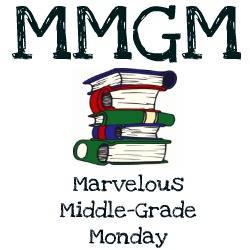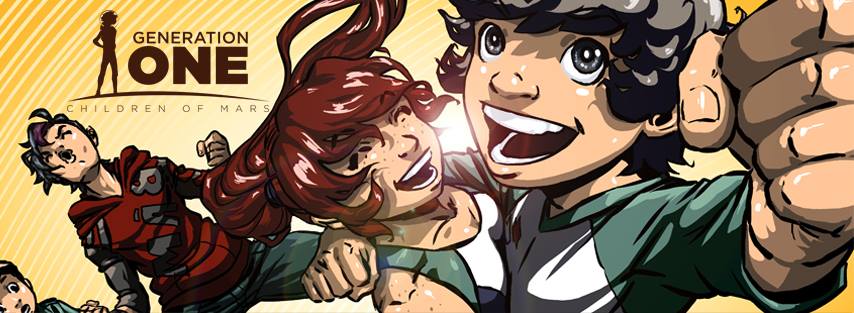Tell us a bit about Gen One: Children of Mars. Who do you see as the target audience? And, where and when can folks get a copy, if they’re interested?
The story is about the first generation of kids born on Mars (as well as a couple of colonist kids from Earth) and how they all come together to keep war from coming to their planet. I’ve always been fascinated by the way people more or less accept the world they’re presented with, and it got me thinking, hey, what would a kid who has never lived on Earth be like? What would they think of our rules and prejudices? That’s really what got the idea rolling, but it grew into much more than that. Now it’s about war and family and dirty politics and the concept of home and so many other things. I’m really excited for people to read it.
As for the audience, I will freely admit I’m terrible at gauging what is good for who to read. I tend to think kids should be able to read pretty much whatever they want, no matter how scary or challenging, because those are the kinds of reading experiences that stretch you and make you think. I’ve always felt that if someone tells you not to read something, you must. There’s something good in there they don’t want you to know. So while Gen One doesn’t contain sex or bad language, there is no shortage of challenging material. Violence, abuse, betrayal. There’s some heavy stuff in there, but I think kids can handle it. If you’re old enough to read the words, you’re old enough to experience the story as far as I’m concerned.Â
As for where you can get a copy, that’s up in the air. We’re still just trying to make the best book we can. Once it’s done, we’ll be looking for a publisher/distributor who will hopefully get the book into more hands than I could ever do alone. But I will have a few extra copies lying around if people contact me wanting to buy a copy black market-style.
Black market-style! Â That almost makes me wish I didn’t already have a ‘legal’ copy coming. 🙂 Â What do you feel have been the highlights so far, of working on a project like this?
Seeing people get behind your work is an incredible feeling. As a writer/creator, you work for a long time to get people to notice what you’re doing. I can remember carrying around stories I had written and printed out, jumping at the chance to give them to a willing friend or supportive teacher. Somewhere between then and now, people starting asking me where they could read my stories. Gen One has been easily the most attention my work has ever gotten, and that feels good. Interacting with the fans directly has been amazing, and their enthusiasm helps keep me motivated during the tough days.Â
The only thing better is getting the illustrated pages from Tim. Every time I get new art, it blows my mind. It makes the story and its characters so fresh and real to me. I get to see scenes that existed only in my imagination come to life in full color.Â
Working with Rusty on the script is pretty great too. When we break through a particularly tough story issue, that ah-ha rush is like nothing else.Â
I can only imagine that feeling, but it sounds amazing!  Did you know ahead of time you’d be able to work with a team on something creative? Were there adjustments you had to make?
Team Gen One is made up exclusively of friends and family. We knew we wanted to work together long before we settled on a project. In fact, our first idea for a comic book was a story about an orphanage where all the kids are clones of famous serial killers. Tim was so uncomfortable with the concept, he actually wanted to bow out at one point. I chose the person over the project, and we completely switched gears. I have a document of story ideas a mile long on my computer, so I dug around and we found something we were all passionate about. I don’t regret the decision a bit. There are always new ideas; collaborators are much harder to come by.
I’ve always assumed I wasn’t the collaborative type, but you make me wonder if I’m missing out.  Talk to us about the process of writing a story for the graphic novel format. How does that compare to writing a story that’s not going to be illustrated?
It’s much harder than writing novels or stories. If writing fiction is like building a house, writing comics is like trying to build that same house inside a phone booth. Space becomes your number one concern, and you end up having to keep so much in your mind all at once. What page is going to be on the left, and what page will be on the right. How much detail can visually fit in a panel. How much dialogue can fit in a word balloon. One action per panel. Five panels to a page. Don’t forget to keep surprises on the even numbers so the reader sees them as they turn the page. Want to make a story change? Now all that crap has to shift. It’s a nightmare, but when you wake up and see the result, it’s all worth it.
Wow, it sounds…intense. Â What do you see as the advantages of telling a story in the graphic novel format, for both the creator and the reader?
This might sound weird, but credibility is the number one benefit to the creators. When an artist is good, people know it at a glance. They don’t have to read a few pages to know they like the style, the colors, the flow of the art. Writing is much more subjective, and it takes much longer to sell a reader on pure text. They have to settle in, get their bearings, get to know you a bit. Art is instantaneous.Â
As for the reader, they get to experience that incredible thing that happens when you read comics: the fusion of separate elements into a single whole. When you’ve been reading comics for a while, your brain becomes expert at taking the art and the text and the flow of the panels and turning it all into a movie in your head. Sometimes you can almost hear the music. And really, isn’t it a relief to just know what the locations and characters look like? Isn’t that better than those awful “so-and-so caught the reflection of their dark brown eyes in the mirror†scenes? Or god forbid, “the room was thirty by thirty-five feet with high ceilings.†Gag me with my keyboard. Description can be done right in fiction, but it’s okay to let the art do the work sometimes. It still counts as reading. 😉
Of course it does! Â And I know what you mean, with art. Â The eye tells us instantly if an arm or a face is off. Â Tell us what other projects you have on the back burner. Â What do you plan to do once Gen One has come out?
What do I plan to do?! SLEEP! I will dive into my bed like it’s an Olympic swimming pool and power-coma my way through an entire week. Then I’ll get all depressed and feeling like a fake and have to get up and write something so I can feel like myself again. What will I write? I’ve got a few horror stories I can’t wait to write. There’s one about a haunted boxing ring, and another one about an old lady who hasn’t seen the upstairs of her house in fifteen years, and another one about a guy who lives near a change in time-zone because if he’s ever around at 3:00 am, something really awful catches up to him. Then I’ll start on the new novel, start trying to sell the previous one, and go back to not sleeping.
Those all sound great!  Very intriguing.  For our last question, a query from Apricot-kitty.
 “Are there any cats on the mars in which your characters live? What about other animals?”
“Are there any cats on the mars in which your characters live? What about other animals?”Sorry, Apricot-kitty. There are no cats on Mars at the time of the comic. If you want to change that fact, you’ve got some work to do. I recommend getting in touch with Bas Lansdorp or Elon Musk or Robert Zubrin. Just be prepared to pitch your idea for why cats belong on Mars. Be a real salesman about it. Features and benefits, Apricot-kitty. Features and benefits.Â
The only animals on Mars that appear in the comic are fish (delish!) from the aquaponics portion of the greenhouse and one lonely octopus named October. I’m not really sure what he’s doing up there, but Ada seems pretty fond of him. If you look really closely, you might see him sneaking out of his aquarium to steal a fish or two.
An octopus named October! Â I love it. Â And can’t wait to meet him. Â Many thanks, Steve, for a truly fantastic interview, and best of luck as you build toward the release of Gen One!
Next Monday will be our very last post on graphic novels, etc., and will be a guest blog on the subject by a PhD and researcher who is something of an expert on the subject! Â I hope to see you all then. Â For now, stop by
Shannon Messenger’s blog for the full round up of Marvelous Middle Grade Monday interviews, reviews, spotlights and giveaways, and happy reading!




Greg Pattridge
Suzanne Warr
Sue Heavenrich
Suzanne Warr